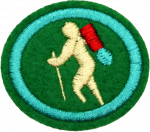Difference between revisions of "AY Honors/Backpacking/Answer Key/es"
(Created page with "{{clear}}") |
(Created page with "{{clear}}") |
||
| Line 193: | Line 193: | ||
{{clear}} | {{clear}} | ||
| − | + | {{clear}} | |
'''Stick method''' | '''Stick method''' | ||
Revision as of 17:33, 12 January 2021
| Excursionismo | ||
|---|---|---|
| Asociación General
|
Destreza: 2 Año de introducción: 1986 |
|
Requisitos
|
La especialidad de Excursionismo es un componente de la Maestría Vida Primitiva. |
|
La especialidad de Excursionismo es un componente de la Maestría Recreación. |
| Conexión Logros para la Investidura: Esta especialidad está relacionada con los requisitos de Logros para la Investidura para VIAJERO AL AIRE LIBRE Vida al Aire Libre y GUÍA DE VIDA PRIMITIVA Vida al Aire Libre que requiere el desarrollo completo de esta especialidad o uno de 4 otros, no obtenida previamente. |
1
2
3
4
5
Sacos de Dormir
Adventist Youth Honors Answer Book/Camping/Sleeping bags/es
Almohadillas
Adventist Youth Honors Answer Book/Camping/Sleeping pads/es
6
7
7a
7b
7c
8
8a
8b
8c
8d
8e
8f
8g
8h
8i
9
10
Un adulto no debe llevar más de un quinto a un tercio de su peso corporal en una mochila, dependiendo de su estado físico. Un niño no debe cargar más de una cuarta parte de su peso corporal.
11
Adventist Youth Honors Answer Book/Camping/No compass/es
Stick method
This method is a waste of time. We all know the sun rises in the East and sets in the West. The stick shadow shows you this. Also when the sun is at its zenith the highest it gets in the Southern Hemi look at the sun and it is towards the North the opposite in the Northern Hemi. So we learn that at mid day is the best time to find North (or South).
But if you must... place a stick in the ground on an open area. Mark the shadows at times through out the day. From this you can find North or South (depending what side of the equator you are on) from the shortest shadow and also East and West by drawing a line from the ends of the longest shadows assuming you had an early morning and late evening marking with equal time from mid-day. But for this you have to be lucky to have sunshine for most of the day, which usually is not the case if you are lost. Anyhow it is something to know if you do not have a watch to know when mid-day is.
12
- Alone
- Set the backpack on a table (or a large rock), put your arms through the straps (loosened off), and lift with your legs. You can also set it on a rock or a log and sit down in front of it. Again, lift with your legs, not with your back. If there is nothing available to set your pack on; stand with your feet apart, one leg ahead of the other, knee bent enough to set your pack on it. With shoulder straps loosened off, slip one arm through the shoulder strap, lean into your pack and slightly downward, and roll it up onto your back. Once in place, slide your other arm through the shoulder strap. Always tighten your hip belt first, shoulder straps next and lastly your chest strap. Reverse this procedure for removing your pack.
- With a Partner
- Have your partner lift your pack and hold it while you slip your arms into the straps. If you have to stoop, bend your knees. Remember to lift with your legs!
13
Five miles is a good backpacking trip for a beginner. Find a trail near you by visiting your local outdoor outfitter. These stores are most often staffed by people who enjoy backpacking and can provide you with valuable advice on destinations. Once you've got a 5-mile trip under your belt, why not look at the Pioneering honor and make your next trip a 15-miler? If you make it a 15-mile hike, you can also count this backpack trip toward the hardest requirement of the Hiking Honor.
References
- http://www.patc.net/hiking/gear/packs.html
- http://gorp.away.com/gorp/eclectic/family/expert/ask_exp.htm
- Categoría: Tiene imagen de insignia
- Adventist Youth Honors Answer Book/Honors/es
- Adventist Youth Honors Answer Book/es
- Adventist Youth Honors Answer Book/Skill Level 2/es
- Categoría: Libro de respuestas de especialidades JA/Especialidades introducidas en 1986
- Adventist Youth Honors Answer Book/General Conference/es
- Adventist Youth Honors Answer Book/Recreation/es
- Adventist Youth Honors Answer Book/Recreation/Primary/es
- Adventist Youth Honors Answer Book/Stage 25/es
- Adventist Youth Honors Answer Book/Wilderness Master Award/es
- Adventist Youth Honors Answer Book/Recreation Master Award/es
- Adventist Youth Honors Answer Book/IAConnection/es
- Adventist Youth Honors Answer Book


